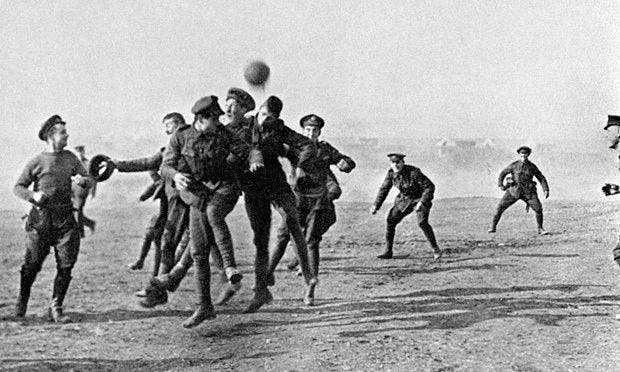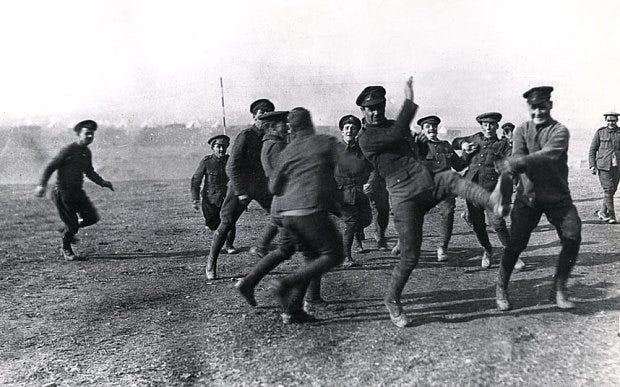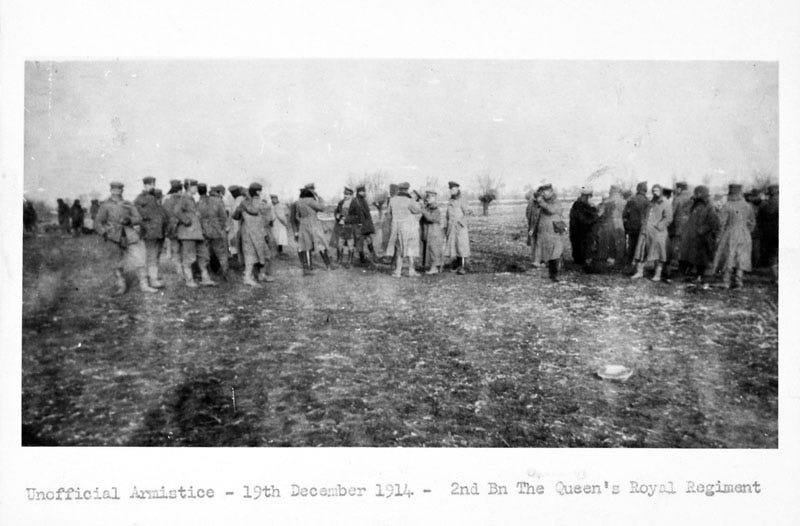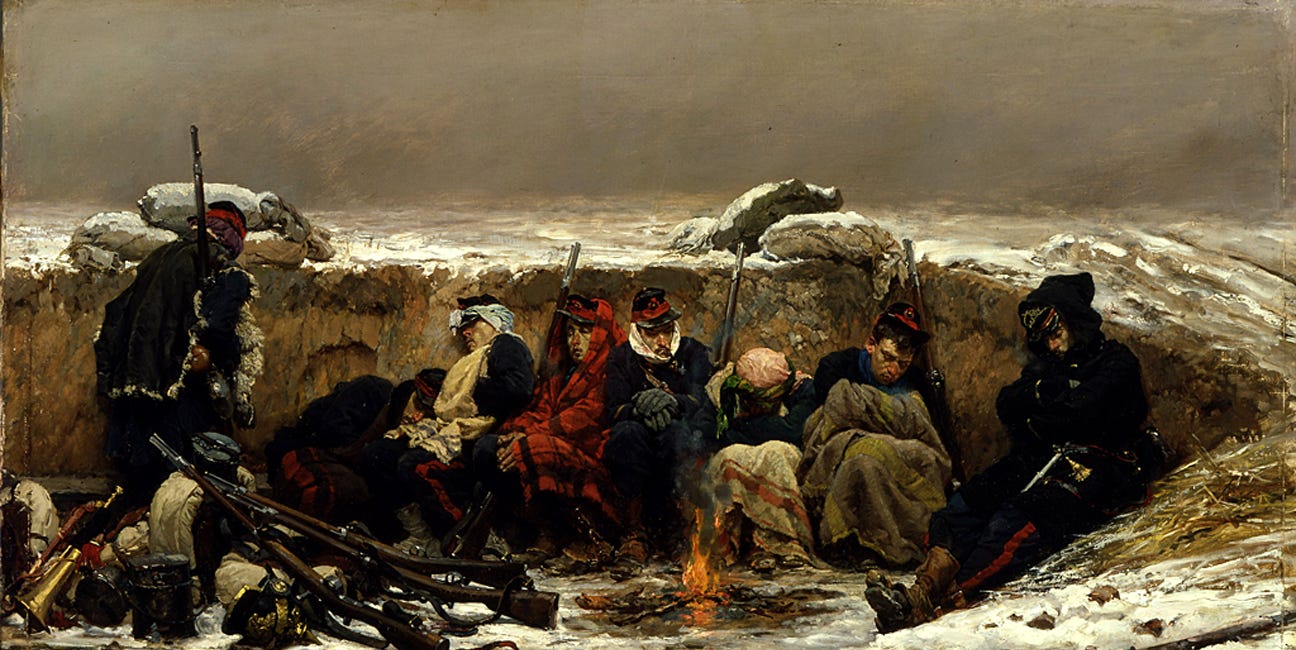The 'Unauthorized Armistices' of 1914 and the Making of Modern Mass Memory
A reposted book review
Originally published in 2022, when I had a fraction of my current subscribers.
Terri Blom Crocker. The Christmas Truce: Myth, Memory, and the First World War. University of Kentucky Press, 2015. 310 pages.
Although Terri Blom Crocker has done admirable and important work in untangling the story of how the so-called “Christmas truce” of 1914 really happened, I have one great criticism, which is that she still uses the singular, and calls it a Christmas truce, despite recognizing that no monolithic event occurred at all.
To be blunt, “the Christmas truce” is a myth, and Crocker participates in the myth by repeating its name.
Local truces occurred all throughout December, as Crocker explains. British soldiers wrote home about these events. No one censored their mail. Some soldiers sent their letters to hometown newspapers, while others were shared with papers by soldiers’ families — again, all through the month of December, Crocker notes.
Despite speculations beforehand that a “Christmas truce” might happen, on 28 December British newspaper headlines reported “NO CHRISTMAS TRUCE.” Only six days after Christmas, in the evening editions of the 31st of December, the lowest-readership news cycle in Britain at that time, did the news of a “CHRISTMAS TRUCE” suddenly appear as a headline, and dominate the pages for three weeks.
Seems a bit sus, if you ask me.
That sort of arrangement where a compliant media withholds reporting on a story, for whatever reason, has a name in the news business: an embargo.
“In journalism and public relations, a news embargo or press embargo is a request or requirement by a source that the information or news provided by that source not be published until a certain date or certain conditions have been met,” Wikipedia says. “The media is given advance knowledge of details being held secret so that reports can be prepared to coincide with the announcement date and yet still meet press time.”
Corporate news organizations massaging the information they report, especially in wartime, is nothing new. Crocker argues that the truth of these truce events has been hidden for a century, ever since it burst onto the public consciousness under a false headline, and that should not be strange to us by now. Her book tells the story of how the English-speaking world, in particular, convinced itself that peace had broken out for a day.
She still uses the lie in her title. She has to, for otherwise no one would know what it was about.
A romanticized version of the December truces has dominated the discourse since the 1960s, Crocker explains. This is because our public consensus about the war was unformed until after the Second World War had banished the idea that the First had been a ‘war to end all wars.’ In fact, no consensus about the meaningfulness or uselessness of the first war existed until the second had been over for more than a decade.
Even critical authors left it out of their books or glossed it over. Robert Graves introduced a narrative of disillusionment in 1929, for example, yet Goodbye to All That barely mentions “the” Christmas truce at all, giving it little significance. Fast-forward 30 years, and Graves is tearfully, fondly recalling the glorious soccer games and fellowship of no man’s land on television. His memory has changed with time.
“The generally accepted narrative of the Christmas truce as a soldier’s rebellion against the tragic waste of the war” is wrong, Crocker writes. From the 1960s through the 1980s, a generation that was removed from the Second World War, and lived the grip of a nuclear Cold War, as well as a simultaneous Vietnam hot war, repurposed the events of December 1914 as a pacifist fairy tale.
Criticism of the British Army as “lions led by donkeys” during the war has been debunked by military historians, but it remains powerful even today because it speaks to the wars we are still having.
The reality of what happened that December remains obscured by a popular myth. Writers, poets, songwriters, and documentarians have all made selective use of veterans’ accounts to shape narratives of the Christmas Truce as an anti-war protest. By the 1990s, a mythical version of the Christmas Truce had become impossible to dislodge from the public imagination.
Crocker is best explaining how this happened: in musical comedies and stage plays; on page and on screen; in novels and memoirs; in documentaries, where creative liberties shaped a false picture of “the” Christmas truce, for example by making generals into villains.
It is absolutely false that commanders were in the dark about truce events in December. Crocker cites, for example, the war diary of the 25th Brigade of IV Corps, which shows that superiors were told in detail about the truces taking place in all five subordinate battalions. One entry shows that the truce in a sector had been “reported personally by Adjutant to O.C. [officer in charge] 25th Brigade at 9 am.”
Maj. Gen. Smith-Dorrien, commander of II Corps, had his chief of staff, Gen. George Forestier-Walker, issue a memorandum specifically prohibiting truces on 4 December precisely because he was aware that they were already happening in the front lines.
Terminology varied, but perhaps the most indicative term used to refer to truce events in these diaries was “unofficial armistices.” Below is an authenticated photograph of one of these events — taking place six days before Christmas. Note that officers seem to be meeting officers in the middle, while the enlisteds appear to be meeting enlisteds. The social hierarchies of European cultures are not collapsing before us. No proletarian uprising is taking place here. This is no revolution. It is not a party. It is not peace. It is also not safe.
A colonel complains that the Germans would “shoot one of our officers dead who was doing his half of the truce.” A private of the 5th Cameroonians is standing unarmed in no man’s land when an accidental shot is fired behind him, so the German sniper overseeing the truce shoots him dead. At least eight British solders died on Christmas Day during truce events, and there were others throughout the month. Resentment of these deaths deterred some men from participating any further, or at all. Both sides were on their guard against treachery.
Far from losing control, both armies were fully in control of their formations. Nowhere in the primary sources is there evidence of the chain of command breaking, or military discipline breaking down, or soldiers engaged in mass disobedience. No one photographed in no man’s land holds a weapon; their rifles are being held for them in the trench behind, a sure sign that military discipline is still in effect. Officers are present and in command. No one is singing kumbayah, and no one is kicking a soccer ball, either.
Each truce was a local event, negotiated by the local commanders, with their arrangement shaped to local conditions. Thus “in spite of the widespread nature of the various cease-fires…the form the truce took varied widely in different parts of the British-German line,” Crocker writes. Rather than a peace protest, each truce was “a response by professional soldiers to the holiday season and the unusual proximity with the enemy on the Western Front.”
Exactly half the British battalions in the front line engaged in a truce on Christmas Day. Exactly half did not. One unit might be observing a truce next to another unit that was loudly at war.
Burial details, as Crocker says, are the most common activity reported during these truces. Corpses had been piling up in no man’s land for weeks.
As an “informal truce reigned” on the evening of 26 December, the 2nd Rifles also reported that “opportunity was taken to do a lot of work in the open and mending wire.” Trenches were flooded and parapets were collapsing; draining and sandbagging work is much easier at ground level, outside of the trench.
Local commanders on both sides were adapting to the wet, cold conditions of an unexpected battlefield, using these truces as an opportunity to cope.
Interaction with the enemy also gave intelligence officers a chance to learn about their enemy’s order of battle. Crocker shows that “the 7th Division was able to collect more intelligence about the Germans, their positions in the line, and the defenses opposite them than the 5th Division, which tried to shut its truces down rapidly.” Shown the intelligence gathered by units in his own corps, Smith-Dorrien elected to waive any punishments.
In fact, no one was ever punished. As Crocker establishes, the popular notion that both armies had to be dragged back into battle, kicking and screaming, is a complete fabrication. British soldiers came back to their own side reporting that the enemy was entirely confident of victory. They themselves expressed total confidence in victory.
Crocker finds no evidence in the primary sources that anyone had trouble shooting at the other side afterwards. “Generally, the diaries of battalions in the line at this time reported that fraternization came to an end by the evening of Christmas or Boxing Day,” she writes, “cease-fires generally persisted for a few days afterward, firing began to pick up again just before or on New Year’s Day, and the war was restarted in earnest sometime during January 1915, but they rarely recorded any orders that battalions were to resume fighting.”
“Football matches are rarely mentioned in regimental histories,” Crocker writes. With so much work to do burying bodies and repairing wire, and less than nine hours of daylight on Christmas Day, the reader can understand why this writer, a military veteran, chooses skepticism here. Sergeants have limited patience for jolly games when there are deficiencies to fix.
After intensive study, Crocker finds little evidence to substantiate such stories. Nevertheless, they captured the public imagination like nothing else did. “Although most of the stories of football games were rumors rather than reality, the fact that so many soldiers reported hearing that they took place has given the mostly mythical games an air of unreality and embedded them firmly in the collective memory of the truce.”
Nor was this the very first time such truce events had occurred. On the contrary, they had been the norm in European warfare for centuries, whenever troops found themselves in close proximity for long periods of time. Field Marshall Sir John French, the commander of British Expeditionary Force, and another general who has been unfairly made a villain in the story of the Christmas truce, personally sent gifts of whiskey and cigars to an enemy commander for Christmas during the Boer War.
Soldiers, French later opined, ought to “cultivate a freemasonry of their own and, emulating the knights of old…honor a brave enemy only second to a comrade.” It was a sentiment of the old world that was being destroyed. For although we now remember the December truces as if they were an historic first, they stand out as an historic last.
Not only did the Second World War dispel the illusion that wars had ended forever, it was defined by even greater cruelty than before. Crocker does not expand on this point in her thesis, but perhaps no single book could contain the entire problem of our shared false memory. Like the war itself, the topic is too big for a single volume.
The Art Of Life Under Siege At Christmas-Time
Originally published one year ago when I had less than one-third of my current subscribers.





